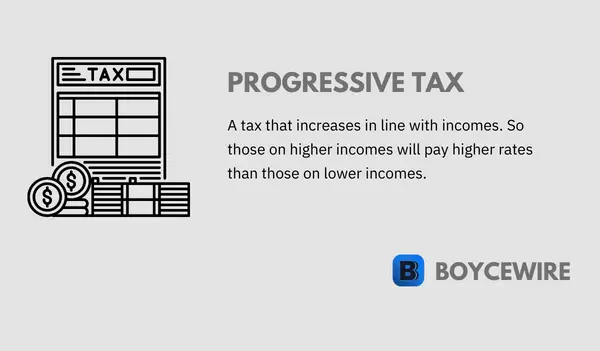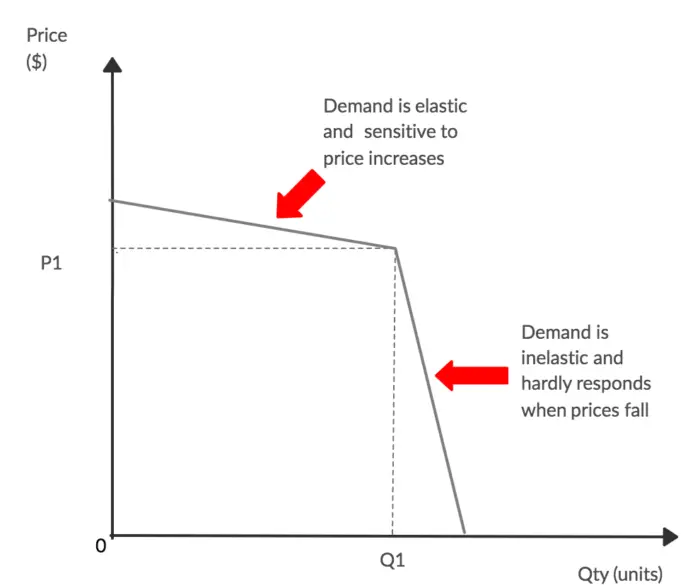Progressive Tax: Definition, Pros, Cons & Examples

What is a Progressive Tax
A Progressive tax is where taxes increase in line with incomes. In other words, the higher the income, the higher the rate of taxation. For example, someone earning $20,000 a year may pay 10 percent in taxes, whilst someone else earning $80,000 will pay 30 percent. This is said to be the fairest and most equitable of taxes.
It is argued that the more an individual earns, the more they should pay in taxes – thereby contributing back to society. This derives from the idea that an additional $100 to someone earning $100,000 means far less than someone earning $20,000. Under marginal utility theory, additional income would start to diminish in value for those with a higher income. Therefore, it is argued that it would be better to re-distributed to the poor.
Key Points
- A progressive tax is one which increases as incomes increase.
- An example of the progressive tax includes the estate tax whereby a tax is levied on estates with a value of over $5.3 million.
- The progressive tax is seen as fair by many as it re-distributes income away from rich households and reduces the burden on the poor.
A progressive tax is seen as the epitome of equality. By increasing the tax burden on the rich, who can afford to pay more, it, therefore, reduces the tax burden on the poor. The larger the increase in tax rate between poor and rich, the more progressive the tax is. For instance, a tax of 10 percent on incomes up to $20,000 and another 20 percent on incomes over $250,000 is a progressive tax. However, a more progressive tax would be if there was a 0 percent tax on incomes up to $20,000 and an 80 percent tax on incomes over $250,000.
The more progressive the tax, the more pronounced the effects will be – particularly if there are fewer brackets. So if the tax rate jumps from 20 percent to 60 percent, then people will be disincentivized to move into the higher tax bracket. In turn, progressive taxes need to have a number of small, incremental brackets to be most effective. However, it creates a much more complex system to administer.
Progressive Tax Examples
Capital Gains Tax
In the United States, the capital gains tax is 0 percent for those on incomes up to $40k. This increases to 15 percent on incomes between $40k and $445k for single individuals. For those who earn even more, the rate increases further to 20 percent.
Even though the leap from the ‘middle’ tax rate of 15 percent, to that of 20 percent is not that significant, it still classifies as a progressive tax. This is because the higher the level of income, the higher the rate of taxation. Yet at the same time, there is further room to make the current rates more progressive by splitting down the brackets more.
Estate Tax
In the US, the estate tax is currently 40 percent for those whose estate is valued in excess of $5.3 million ($10.6 million for a married couple). Those with an estate below this value pay nothing, which means that 99.9 percent of individuals pay no tax on their estate. So only wealthy individuals end up paying the tax. This is a progressive tax but would be more ‘progressive’ if it increased in more frequent increments and went up into even higher brackets for those who earn even more.
Income Tax
In the United States, the income tax system is progressive with seven tax brackets that increase alongside income, with rates of – 10%, 12%, 22%, 24%, 32%, 35% and 37%. Some may say that this is not progressive enough, but as the rich pay a higher rate on income than low-income households, it is still a progressive tax. The issue of the rich avoiding it through loopholes is another issue entirely.
Luxury Sales Tax
Ordinary sales taxes can disproportionately affect the poor as they are flat taxes that are levied on every. As the poor spend a higher proportion of their incomes, they end up paying a higher rate of taxation. Yet a luxury sales tax would be implemented on goods that have a high mark up. For example, goods like Gucci handbags, Rolex watches, or Ferraris are all items that are afforded by the rich. So placing a tax on these goods would effectively be progressive, as it shifts the sales tax burden away from the poor.
Advantages of a Progressive Tax

1. Reduces Burden on Poor
A progressive tax ensures that those earning more pay a higher percentage than those at the bottom of the income spectrum. This allows the government to reduce taxes on the poor, whilst recouping the income from high-income earners. In turn, those at the bottom of the distribution are able to keep more of their money and increase their disposable income.
2. Higher Revenue
By taxing the rich more, the government may in fact increase its revenue – although this may depend on how they react, i.e. moving income to an offshore account. However, this may bring in more revenue up to a certain point, especially if the rate is still competitive with other nations. For example, a progressive tax that went from 10 all the way to 50 percent may help increase revenues – particularly if this is similar to other nations. Those on a higher income would be paying a higher rate of 50 percent as opposed to 10.
3. Support for the poor
A more progressive tax system can bring in higher levels of revenue, which is needed in order to provide social security services. It helps to provide the necessary revenue to fund housing assistance, unemployment benefits, disability benefits, as well as income support for those on low incomes.
4. Reduces Inequality
One of the biggest issues with regard to inequality is that of underfunded public services. The argument is that when services such as public education are underfunded, it creates a poverty trap whereby individuals are unable to access sufficient skills to move up the income ladder. By increasing the tax on higher-income households, they are able to subsidize such public services that will benefit the poor and help them up. At the same time, it reduces the gap in disposable income between the rich and poor.
5. Lower economic inequality
A progressive tax can help increase the level of disposable income of low-income households, whilst reducing the disposable income of high-income households. This allows the poor to be able to afford more goods, whilst reducing the amount that the rich can buy. It may help reduce what is known as ‘wasteful spending’ on goods such as gold-encrusted iPhones. Instead, those resources can be employed to more efficient means to help the poor.
Disadvantages of a Progressive Tax

1. Disincentivizes Wealth creation
By taxing the rich disproportionately more than those on lower incomes, a disincentive is created. For instance, why would someone want to work 100-hour weeks if the government takes 80 percent of that away? By doing so, there is an incentive to work less and therefore create less economic output. At the same time, it can create a drag on entrepreneurship. If entrepreneurs are discouraged from opening new businesses, it provides a net drain on the economy. There is less competition, less choice, and
2. Lower Government Revenue
Depending on how progressive the tax system is, it could actually lead to lower levels of government revenue. For instance, people will be disincentivized to work hard and move into higher tax brackets. What’s the point in working 100-hour weeks when you get paid, after-tax, the same as someone doing 50 hours? At the same time, the tax rate may encourage high-income individuals to move their income abroad and evade taxation completely. In turn, this has the opposite effect as the government receives nothing instead.
3. Capital Flight
Progressive taxes, particularly on income and capital can lead to individuals moving capital abroad and investing in other nations. If the tax rate is particularly progressive, I.e. it increases from 10 percent to 80 percent, then those at the top may find it beneficial to go elsewhere. In reality, it will depend on what the top rate is for the highest income earners. If it is too high and not competitive with other nations, then capital flight may result.
4. High Administrative Costs
A truly progressive tax will increase gradually alongside income. However, this can create a large number of brackets. For instance, you may have 10 brackets with an incremental increase in the tax rate. This may increase from 20 percent to 25 percent, and then all the way up to 70 percent in 5 percent increments. This would be a progressive system, but it would be extremely difficult to manage. At the same time, it would cost the IRS millions to administer, whilst also proving a headache for those who self-file their tax returns.
5. Poorly Defined
A tax that charges 20 percent for those earning less than $30,000 a year and 22 percent on those earning over $200,000, is still a progressive tax – it charges a higher rate to those earning more. However, the progressive rate is very minimal. Whilst it is defined as a progressive tax, many would say that it’s not progressive at all. And this is where the issue lies. It is very poorly defined in the fact that each individual will have a different opinion on what a truly ‘progressive tax’ is.
Related Topics
FAQs
The estate tax is a type of progressive tax. It taxes rich estates at a higher rate than those with small estates.
Progressive taxes work by taxing richer households a higher percentage of their incomes, whilst taxing poorer people a lower percentage.
A progressive tax is not necessarily good. It depends on how extensive the progressive tax is and how individuals act to those incentives. If it encourages the rich to move abroad, it could have a detrimental affect, whilst it could in fact help reduce the burden on the poor otherwise.
About Paul
Paul Boyce is an economics editor with over 10 years experience in the industry. Currently working as a consultant within the financial services sector, Paul is the CEO and chief editor of BoyceWire. He has written publications for FEE, the Mises Institute, and many others.

Further Reading
 Pygmalion Effect: Definition, How it works & Example - The Pygmalion effect is where an individual’s performance is influenced by others’ expectations. In other words, higher expectations lead to…
Pygmalion Effect: Definition, How it works & Example - The Pygmalion effect is where an individual’s performance is influenced by others’ expectations. In other words, higher expectations lead to…  Price Gouging: Definition & Examples - Price gouging is where the seller increases the prices of their goods or services to a level considered unreasonable and…
Price Gouging: Definition & Examples - Price gouging is where the seller increases the prices of their goods or services to a level considered unreasonable and…  Oligopoly: Definition, Characteristics & Examples - Oligopoly is derived from the Latin ‘olígoi’ – meaning “few”, and ‘pōléō’ – meaning “to sell”. So loosely translated, it…
Oligopoly: Definition, Characteristics & Examples - Oligopoly is derived from the Latin ‘olígoi’ – meaning “few”, and ‘pōléō’ – meaning “to sell”. So loosely translated, it… 